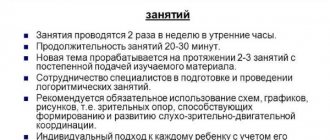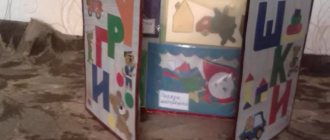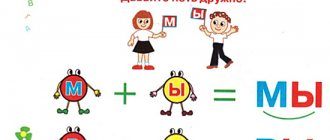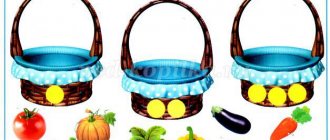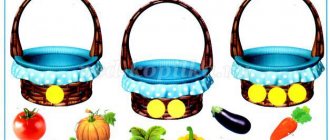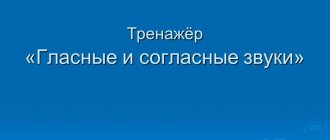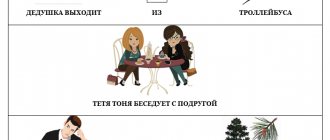Games and exercises to consolidate sound pronunciation and develop phonemic awareness
Games and exercises
on consolidation
sound pronunciation and development
phonemic representations
1
Exercise “What sound is in the word? "
Target:
To develop phonemic hearing, speech attention of children, to consolidate the pronunciation of the sounds S, S in words.
Material.
A picture whose title contains the sound
s
or
s
'; flannelograph; blue and green circles.
Progress:
Educator. We sang songs of the big and small pumps. Their songs are similar to the sounds in words: with
- big brother, s' - little brother.
Children are given pictures (an approximate list of them: bag, leaf, snowman, airplane, tit, cabbage, sleigh, cornflower, lilac, pig, goose, little fox, bicycle, month...).
Educator. The names of our items contain sounds with
or with'.
Listen to how I name the objects: “ Sssdog
is the sound
with
, “
sssinichka
” is the sound
with
'.
- Now you will name your objects and say what sound is in this word.
Children take turns going to the board, name the object, determine the presence of a particular sound and put the picture on the flannelgraph after the blue one (sound with
) or after green (sound
with
) circle.
Then one child names all the words with the sound s, the other - with the sound s
‘.
2 Game "Birds"
Target:
Develop speech attention, phonemic hearing, consolidate the pronunciation of the sounds I, Yu.
Material.
For each child and teacher, one yellow or red square (the teacher has both squares); flannelgraph and pictures depicting a chicken, kitten, kid, dog, bush, hen.
Progress:
Teacher (distributing yellow squares to one half of the group and red squares to the other).
You are birds. Those who have a red square will sing: “Yu-yu-yu-yu-yuuuu”, those who have a yellow one will sing: “Ya-ya-ya-yaaaa.” See which square I will lift and sing songs of different birds.
The teacher raises the squares in random order, and the children sing the corresponding songs (3 times). Then the children change roles and the game is repeated.
3
Game “Bells”
Purpose:
To develop children's speech attention and phonemic hearing, to consolidate the pronunciation of the sounds Z, ZZ in words.
Material.
Large and small mugs of any color; flannelgraph and blue and green mugs; pictures depicting a hare, a basket, a fence, strawberries, a goat, a rose, a mirror, an umbrella.
Children are divided into two groups - large and small bells. They face each other.
Educator. Big bells ring: “Dzyazyn-dzzyn-dzzyn”; the little ones ring: “Dzzzzin-dzzzzin-dzzzzin” (children repeat the sound combinations).
If I show a big circle, the big bells will sing, if I show a small circle, the small bells will sing.
The teacher shows the circles in random order, and the children imitate playing bells and sing the corresponding songs 3 times. Then they change roles and the game is repeated.
4 Exercise “Which bell is ringing?”
Target:
improving the correct pronunciation of the sounds З, Зь.
Educator. When you sang songs of big bells, you pronounced the sound z
- “dzzzin”, when they sang songs of small bells, they pronounced the sound z' - “dzzzzin” for a long time.
The sounds z
and z' are brothers.
Z
is big brother, and z' is little brother.
— I have pictures on the flannelgraph, their names contain these sounds. Listen to how I pronounce the words so that you can clearly hear the songs of the bells: zzzayka What sound in the word have I been dragging out for a long time? (Z.)
Is it big brother or little brother?
(Large.)
I’ll put the picture of ate a blue circle
(children repeat the word emphasizing the sound]
Listen: “Korzzina.” What sound have I been dragging out for a long time?
(Z
'
children repeat the word, and the teacher puts the picture after the green circle.)
Then take turns Children are called, they name objects highlighting these sounds, characterize them - big or little brother, and place them after the corresponding circles.
One child names all words with the sound z, the other - with the sound z'.
5 Exercise “Find your brothers”
Target:
Develop phonemic awareness, consolidate the pronunciation of the sounds K, K in words.
Material.
Flannelograph and pictures: crayfish, doll, matryoshka, squirrel, hedgehog, beetle, flags, whale, cap, sled, balls, apples; blue and green circles.
Progress:
Educator. On my flannelgraph, after the blue circle, there are pictures depicting an object, and the name of which has the sound k
(children repeat the sound - the overtone of a vowel).
- We have already learned to speak loudly
and words.
Let's name objects with the sound k
and pronounce it loudly in words.
Children take turns coming up and naming the object, emphasizing the sound .
(cancer, Doll, matryoshka, squirrel, hedgehog K, beetle).
Educator. Sound k
- big brother, but he has a little brother - sound
k
'
(children repeat the sound 2-3 times).
On my table I have pictures with the sound '
k
' in their names.
Children take turns coming to the table, take a picture, name it, highlighting the sound in the word
', put it on the flannel chart after the green circle (flags, Kit, Cap, sleigh, Balls, apples).
One child names all words with the sound k
', the other - with the sound of
k.
6 Game “Name your brother” (in a circle with a ball)
Educator. You know that sounds have brothers: the big brother has the sound r
- little brother has the sound
p
', big brother has the sound
b
- little brother has the sound
b
'. I will throw the ball to you and call him big brother, and you will call him little brother and throw the ball to me.
In case of difficulty, the teacher himself names the little brother, and gives the child a new task.
All children must take part in the game.
7 Reading a tongue twister
Target:
Reinforce the correct pronunciation of the L sound in a phrase.
The tongue twister is read in two breaths.
Educator. I will read you a tongue twister and show you when I take a breath. (The teacher presses his hand to his chest, inhales, as he exhales, pronounces the words of the tongue twister and moves his hand away from his chest. Do this twice.)
Lena barely ate; she didn’t want to eat out of laziness.
“I took two breaths, and on the exhale I said soon!” debarking Let's also say it together and pronounce the words well.
Then only girls read the tongue twister, then only boys, and at the end three or four children take turns.
8 Game “Catch a Bug” (in a circle with a ball)
Target:
Develop the speech apparatus and diction of children, consolidate the pronunciation of the sound Z in words.
Material.
Ball
Progress:
The teacher throws the ball to the child and pronounces the word emphasizing the sound z
. The child, having caught the ball, repeats the word.
All children must take part in the game.
Educator. Now you will be bugging and buzzing loudly; Seryozha and Lena will try to catch the beetles. But if a beetle lands on a leaf (crouches), you cannot catch it.
The game continues until there are 2-3 winning children left.
9 Game “Name the words”
The teacher asks the children to name words with a given sound, for example, w
(a chip is given for each word).
At the end of the game the winner is determined.
10 Game “Name the sound” (in a circle with a ball)
Target:
strengthening the correct pronunciation of hard and soft consonants.
Educator. I will name words and highlight one sound in them: pronounce it louder or longer. And you must name only this sound. For example, “matrrreshka”, but you should say: “ry”; “molloko” - “l”; "airplane" - "t".
All children take part in the game. Hard and soft consonant sounds are used for emphasis. If the child finds it difficult to answer, the teacher names the sound himself, and the child repeats.
11 Reading a tongue twister.
Target:
develop the speech apparatus and diction of children; consolidate the pronunciation of the sounds D, Дь in a phrase.
The tongue twister is read in two exhalations - two lines per exhalation.
Rain, rain,
Don't rain!
Let me get home
Gray-haired grandfather.
The tongue twister is read in chorus 2 times, then only girls, then only boys and 2-3 children individually.
12 Exercise “Name the first sound of the word.”
Target:
develop phonemic awareness, consolidate the pronunciation of the sounds K, G in words.
Educator. I have different pictures, let's name them (points to the pictures, the children take turns naming them).
I'll tell you a secret: a word has a first sound with which it begins.
Listen to how I name the object and highlight the first sound in the word: “Drum” - b;
“Doll” -
to
;
"Guitar" - g'
.
Children take turns being called to the board, naming the object, emphasizing the first sound, and then the sound is isolated.
